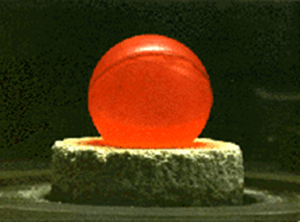Karsten Meyer
Karsten Meyer
Tue, May. 26, 2015, 4:30pm - 6:00pm
Taylor Auditorium, Frick Laboratory
Host: Paul Chirik
From Nuclear Fuels to CO2 Activation at Reactive Uranium Complexes: Chemistry Between Phobia & Enthusiasm
Uranium and its in-traces-existing heavier neighbor, plutonium, are the heaviest naturally occurring elements, and they share one common thing with each other: they undeniably have the worst reputation of all elements of the periodic table.

Photo: Courtesy of Dr. David L. Clark, LANL
In this lecture, a general introduction is given on how radioactivity of naturally abundant and man-made elements, e.g. in plutonium-powered cardiac pacemakers and satellites, impact our modern life. A brief tour through basic inorganic chemistry shows how pitchblende is transformed into nuclear fuels, how organometallic chemists have discovered the element for basic chemical research, and how this field has sparked new discoveries of current interest ever since. In our efforts to activate small molecules of industrial and biological importance, we have turned our attention to coordinatively unsaturated, reactive uranium coordination complexes. For example, the chelating triazacyclononane (tacn), single N, and arene-anchored tris(aryloxide) ligands, (ArO)3tacn3–, (ArO)3N3–, and (ArO)3mes3– have provided access to reactive coordination compounds of uranium in oxidation states II, III, IV, V, and VI with tailorable steric and electronic profiles. These complexes display a pronounced selectivity and reactivity in reactions with carbon dioxide, related small heteroallene molecules (COS and CS2), and H2O. In this seminar, our work on CO2 activation, including unprecedented coordination modes, reductive cleavage, insertion, and functionalization reactions is reported. Most recently, the stoichiometric and catalytic “disproportionation” of CO2 to CO and CO3 2–via reductive cleavage of CO2 was accomplished. In analogy, we were able to isolate an entire series of chalcogenide mixed-carbonate complexes by reacting bridged chalcogenide complexes U‒E‒U (E = S, Se, Te) with CO2, CS2, and COS. The molecular and electronic structure of a new oxidation state in U coordination chemistry is reported; namely U(II), with a 5f 4 quintet ground state. In K(2.2.2-crypt)-[((Ad,MeArO)3mes)U], the U(II) center is supported by δ backbonding. Finally, a rare U(IV) hydroxo complex, [((Ad,MeArO)3mes)U(OH)], with a terminal OH functionality was synthesized by selective oxidation of the U(III) complex [((Ad,MeArO)3mes)U] with H2O. Comprehensive electrochemical studies revealed that the U(III) complex can be regenerated in a catalytic cycle combining chemical and electrochemical reaction steps to produce H2 from water. This combined cycle presents one of the few documented cases of uranium catalysis, and demonstrates the first example of U(IV)–OH bond cleavage. The electrocatalytic cycle described also represents a sustainable strategy towards replacing sacrificial electron donors, such as NEt3 or alkali metals, by electrons provided from an electrode.
Leading References:
H.S. LaPierre, F.W. Heinemann, W. Hieringer and K. Meyer in Angew. Chem. Int. Ed. 2014, 53, 7158.
A.-C. Schmidt, F.W. Heinemann, W.W. Lukens and K. Meyer in J. Am. Chem. Soc. 2014, 136, 11980.
S. Franke, F. W. Heinemann and K. Meyer in Chem. Sci. 2014, 5, 942.
O. P. Lam, S. Franke, F. W. Heinemann and K. Meyer in J. Am. Chem. Soc. 2012, 134, 16877.
A.-C. Schmidt, A. Scheurer, F.W. Heinemann and K. Meyer in Chem. Commun. 2012 , 48, 8634.
S.J. Zuend, O.P.Lam, F.W. Heinemann and K. Meyer in Angew. Chem., Int. Ed. 2011, 50, 10626.
O.P. Lam, F.W. Heinemann and K. Meyer in Angew. Chem., Int. Ed. 2011, 50, 5965.
O. P. Lam, S.C. Bart, F.W. Heinemann and K. Meyer in Chem. Commun. 2010,46, 3137.
A.R. Fox, S.C. Bart, C. Anthon, K. Meyer and C.C. Cummins in Nature 2008, 455, 341.
S.C. Bart, F.W. Heinemann, E. Bill, N.M. Edelstein and K. Meyer in J. Am. Chem. Soc. 2008, 130, 12536.
I. Castro-Rodriguez and K. Meyer in J. Am. Chem. Soc. 2005, 127, 11242.
I. Castro-Rodriguez, H. Nakai, L. Zakharov, A.L. Rheingold and K. Meyer in Science 2004, 305, 1757
